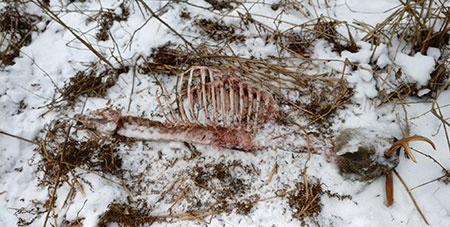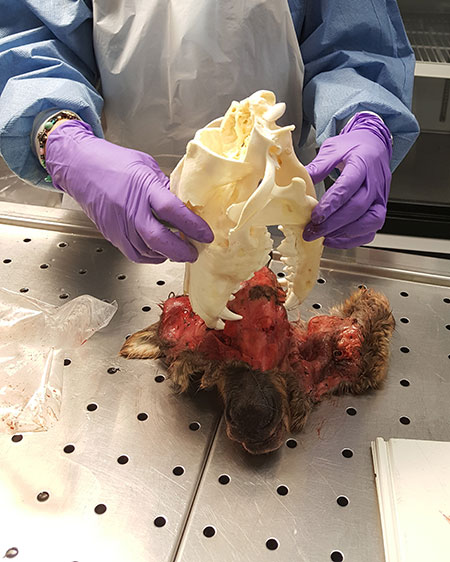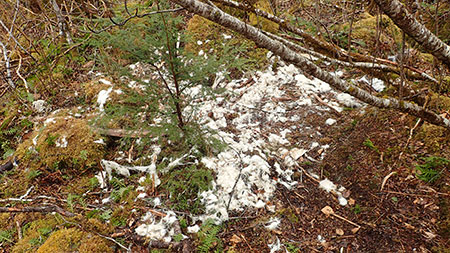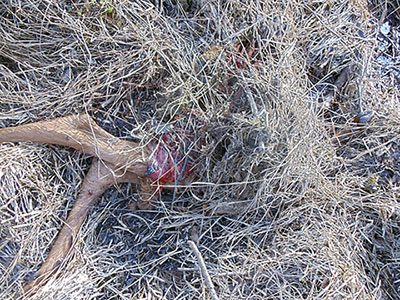Alaska Fish & Wildlife News
April 2018
Kill Site Interpretation
‘Sherlocking’ your way to an answer

The pictures we received at Fish and Game had the caption, “buck slaughtered by wolves.”
Indeed, they were images of a Sitka black-tailed buck carcass lying on top of the snow, but things did not add up. In fact there was quite a bit of evidence that indicated the deer was not killed or even scavenged by wolves. What I looked at in the pictures was that the quarters were all missing, the back straps and neck meat were cleanly gone without damage to bones (i.e. filleted off). The spinal column and ribs were completely intact with no bite marks or breaks, etc. The hide was gone (not in the pictures) up to the base of the skull where it had been skinned. There were long strands of ligaments hanging off of the bone indicating that it was scavenged by birds. But it was not killed by wolves. It was killed and salvaged completely by a hunter, except for the head and antlers. If I were on-site I would have examined the carcass and would’ve likely found a bullet hole as well.
Kill site interpretation is not an easy task and requires a lot of knowledge about animals and their behavior. The evidence left behind is highly variable depending upon the predator and the prey. The more time that passes between when an animal is killed and consumed and when you try and sleuth your way to reenact the scene, makes it even more challenging. Biologists at the Alaska Department of Fish and Game conduct many mortality studies on wildlife populations such as moose and caribou. Often these studies are trying to determine why calves are dying. In order to know this convincingly, newborn calves must be fitted with a radio collar. Biologists then monitor the radio collars for a mortality signal (indicating that the animal is no longer alive) and ideally, they immediately investigate the site. The less time that goes by, the more accurate the cause of death is identifiable. Minimizing time that scavengers have to get to the scene helps investigators decide whether it was wolf predation, bear predation, golden eagle, disease, abortion, etc. depending on what animal species is being studied. Most people don’t have time on their side when they find a dead animal, so it is a more challenging task figuring things out.
Caution is Mandatory- Don’t jump to conclusions and let the evidence speak

A few springs ago I helped retrieve a wolf which was found dead and frozen in the middle of a popular mushing/snowmachine trail in the Chena River State Recreation Area about 35 miles outside of Fairbanks (this entire story was covered by Ned Rozell in the Alaska Science Forum: Mystery of the South Fork Wolf). Several people saw this wolf and assumed that it was shot by someone and left in the trail. But again the evidence did not add up. The wolf had become frozen to the trail and snowed over, and by the time we dug it out some scavenging by small mammals had occurred and confounded the situation. The animal had a couple of big holes in the rib cage on one side, but it looked more like chewed holes, not bullet holes. Also there was no pooling of blood in the snow indicating that the animal was dead before the holes were made. There was really no other obvious damage to the wolf. The only other clue was the evidence of a half-dozen snowed-over wolf beds on the hillside just off the trail where the dead wolf lay.
This is why necropsies are sometimes necessary. The wolf was brought to the ADF&G lab and Dr. Kimberlee Beckmen performed a necropsy on the now-thawed out animal. Within an hour Dr. Beckmen had concluded that this 5-year-old female wolf was killed by other wolves (a common cause of wolf mortality). What we could not see until the hide was skinned back was that animal’s neck looked like hamburger from multiple bites (where there is soft tissue, the tough skin of the wolf can give and not puncture even though massive damage is inflicted to the underlying tissue). It also had a crushed larynx and ultimately a collapsed lung from a puncture through the rib cage. The lesson in this story is not to assume. Situations are complex, and if the answer is not obvious, you have to dig deeper to look for clues. Skinning an animal will always provide some evidence.
Some General Principles
When identifying a kill site don’t just rush over to the animal. If you find a dead deer or moose carcass or a hare in the forest, stop where you are. Rushing in can destroy valuable evidence that may help you determine the cause of death or at least provide clues. Approach slowly and keenly look for any evidence including tracks, scat, blood, feathers, fur, etc. A friend and I once found a cow moose carcass a short distance off the side of a road (ravens gave it away). It was scavenged a bit and had a bullet hole through the ribs. Why would someone just shoot a moose and leave it where it lay? After carefully investigating the area a plausible motive shaped up; we found two subtle, but obvious moose calf beds nearby. The person that shot this cow likely thought it was not accompanied by calves and therefore legal for his or her permit. But, when the calves appeared and the permit violated, the hunter abandoned the moose rather than salvaging the animal and turning him/herself in. We reported it to the troopers.
Resources to Help

Studying the animals in your area and learning mammal and bird tracks and sign is required to be a nature detective. You really have to know what animals inhabit the area and what animals visited the site based on clues like feathers, hair, tracks, or scats, bedding areas, etc. One of the best resources I am aware of for this type of information is the books by Mark Elbroch – Mammal Tracks and Sign, and Bird Tracks and Sign. They are jam packed with images and descriptions about animal behavior, feeding signs, tracks, scats, chewing’s, feathers and more. There is even an entire section dedicated to kill site analysis and determination. It also includes a useful table with inter-canine tooth distances to help you identify animals by their bite marks, if present.
Some typical behaviors
Anyone who spends much time in the field is bound to come across some animal kill sites. When discovering larger mammals such as deer size animals and up, first try and determine whether the animal was killed or died of other causes. In general an animal carcass with legs tucked under its body, as it if it were bedded down, likely died of a non-predatory cause. An animal lying on its side with legs outstretched likely died from predation. There are also other tell-tale clues for those that inquire further. Bleeding is a big one. Animals that die first and are then scavenged are not going to bruise and hemorrhage, internally or externally, like an animal that was mortally wounded during predation.

For the most part, predators of larger prey animals in Alaska include wolves and bears, and in some circumstances wolverine, coyotes and lynx.
If an animal is killed by wolves the carcass is generally ripped apart and spread all over the place as individual animals grab pieces and take them off to feed or cache. The bones of the ribs may be broken to access the organs. They may even be eaten. Wolves have enough force to break the long bones of large hooved animals; something most other predators can’t do. Depending on the number of animals in the pack and prey availability, usually the only thing remaining is some bones, fur, hide, and the stomach contents. Search the area carefully. If wolves spent any time at the site feeding on the animal, there should be tracks and scat around the carcass. There are also times when wolves kill an animal, eat a portion of it, and then abandon it for some reason.
Bears more often prey on smaller hooved animals such as moose and caribou calves but also kill and eat adults opportunistically. According to Danny Caudill, a research biologist with ADF&G who is conducting a moose calf mortality study outside of McGrath, Alaska, he can usually tell right away whether a grizzly bear was at the scene of a moose calf death.
“The entire area is just torn up,” he said.
Sometimes holes are dug in the ground and vegetation ripped up for no apparent reason. Sometimes part of the animal is buried but they usually eat the entire calf. He has even found parts of moose calves mysteriously hanging up in branches of small trees and shrubs, presumably flung there by a violently shaking bear head. If you find a hide that literally looks like it was skinned off the carcass, it was certainly bear predation. Bears skin back the hides of prey before consuming the meat. Another very interesting note from Danny; if his dog is with him at a wolf kill the dog is excited and wagging its tail. When it is a grizzly bear predation site the dog has his tail tucked and sheepishly stays glued to his owner.
If there is part of the carcass remaining and not just a pile of hooves and hair, skinning the carcass and looking at the muscle and organs can reveal a lot. Was the nose cut and crushed or eaten? Is the throat crushed and bruised or hemorrhaged beneath the skin? Are the flanks bitten and bruised? These are all signs of a wolf kill.

Smaller predators and prey can be more difficult to determine because they often do not leave a lot of “leftovers” and eat animals in their entirety. However, there are usually some tracks and sign of some sort left behind and there are many little tell-tale clues in the small mammal and bird world that can help you figure the “crime scene” out. Just one example is finding a bird kill such as a duck or goose. The fact that small carnivores tend to bite and cut the feathers off of such birds rather than plucking them out like a predatory bird such as a falcon will do, is a huge piece of evidence to start with.
There are many more killing and feeding signs that can be attributed to various animals, too many for an exhaustive discussion here. It takes many hours of study and endless practice to become a true Sherlock, but hopefully this will spark your interest and start you on your path of kill-site deduction.
Amazing Trackers
From Mark Elbroch’s – Mammal Tracks and Sign, 2003.
The reconstructions made by trackers can be incredibly accurate. Stander (1979) and colleagues observed a zebra dying of anthrax (blood sampling confirmed the cause), and, over the next several days, a lion pride, hyenas, and vultures feeding and disassembling the carcass. A team of four Ju/’Huan (Namibia) trackers was brought to the area three days after the zebra died and asked to reconstruct what had happened. They investigated that area for two hours, then correctly pointed out the spoor of the zebra and said that the animal was sick and had died from that sickness. They correctly identified all the scavengers and the order in which they fed. They also correctly estimated the relative age of events, including the death of the zebra.
Mike Taras is a wildlife education and outreach specialist for the Alaska Department of Fish and Game in Interior and Northeast Alaska.
Subscribe to be notified about new issues
Receive a monthly notice about new issues and articles.
